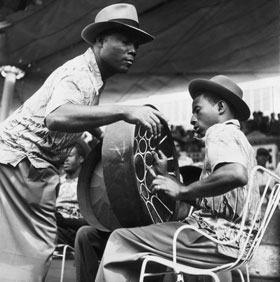Keep on moving
Simply sign up to the Life & Arts myFT Digest -- delivered directly to your inbox.
Sounds Like London: 100 Years of Black Music in the Capital, by Lloyd Bradley, Serpent’s Tail, RRP£12.99, 429 pages
For much of the past century, black music in Britain faced an uphill struggle for mainstream acceptance. An astonishing number of musical evolutions and innovations have taken place, especially in the capital; far too many to chronicle even in an expansive volume such Lloyd Bradley’s Sounds Like London.
This is in many ways a story of success, as those of African and Caribbean descent increasingly found a market willing to embrace their cultural expression via music. Yet there has long been a keen awareness that such acknowledgment can also carry dangers; authenticity and creative control are often the true cost. The complexity of finding a voice to express who you are, where you come from and how you feel, then selling that experience to those outside this collective frame of reference, is a largely unsung narrative of African heritage music across the diaspora, and some would say of African heritage art as a whole.
Bradley, a British music journalist and author of Bass Culture (2000), the first major history of reggae, manages admirably in addressing these issues as he charts the ever more fluid interaction between London and the immigrant population that grew, in subsequent generations, to call the city home. It’s a daunting task, as Bradley admits in his introduction, but even this early on his passion for his subject is obvious. Loosely chronological in structure, Sounds Like London traces the lineage from the first (reported) black band to play in the UK, the Southern Syncopated Orchestra circa 1919, to the dominance of today’s grime and pop artists.
We are a few years shy of an actual century of black music here, but that is hardly the point. Bradley dissects the rise of calypso, steel pan, south and west African influences on modern jazz and progressive rock, the rise and fall of funk, the steady pulse of disco, and the emphatic self-declaration of lover’s rock, a British refashioning of reggae widely regarded as the first black British musical form. He describes the influx of sound system culture, which begat London’s digital age of hardcore, drum and bass, jungle, UK garage, dubstep and grime. As such, this is a lively homage to bands, musicians and songs that might easily have disappeared from view were it not for Bradley’s timely intervention.

I found myself riveted by descriptions of events and people I knew, but had never seen in print; even more so by what I learnt. A case of the latter and, in Bradley’s opinion, “arguably the most noteworthy of the pre-war West-Indian influx”, was Rudolph Dunbar, a Guyanese clarinettist who arrived in 1931. A graduate of New York’s Juilliard school of music, Dunbar was soon fronting his own dance orchestras. He became the first black man to conduct the London Philharmonic at the Royal Albert Hall in 1942, and also conducted the Berlin Philharmonic in 1945, although, as Bradley is keen to point out, “whenever he could, he’d perform works by black composers”.
It is fascinating to read of the musicians who followed in Dunbar’s wake, both before and after the Windrush period, and of how quickly calypso took hold not just of London but the whole country. A young Trinidadian, Edric Connor, brought the first steel band to play in Britain as far back as 1951. He wrote one of the first official football records in 1956, imaginatively titled “Manchester United Calypso”. Tracing the advent of steel pan in the capital, Bradley notes the class-based animosity with which the “trifling” ghetto music of Port of Spain was regarded by many calypsonians.
Sounds Like London is an honest and passionate celebration of not just the music, but the courage, tenacity and guile of the people who made it. There are notable omissions (for instance, R’n’B band Loose Ends, the pirate station London Weekend Radio, and Reinforced Records’ creative monopolisation of the early hardcore scene) but this in no way detracts.
Again and again, musical forms merged with or supplanted one another as new generations rebelled against what had become the staid status quo. Parochial concerns and musical styles from one country, island or region were often forgotten; gender roles were sometimes turned on their head, as in the case of calypso but most evidently in lover’s rock, dominated as it was by female singers. In chronicling this experience, Bradley salutes the pioneers even as he bumps fists with those who continue to lead the way.
Courttia Newland is author of ‘The Gospel According to Cane’ (Telegram Books)
Comments